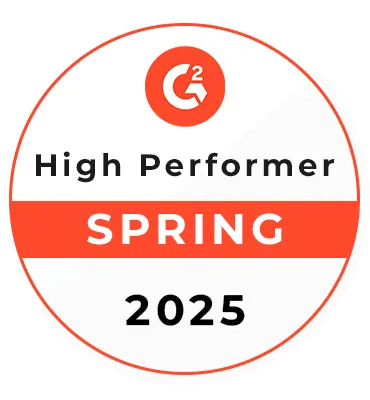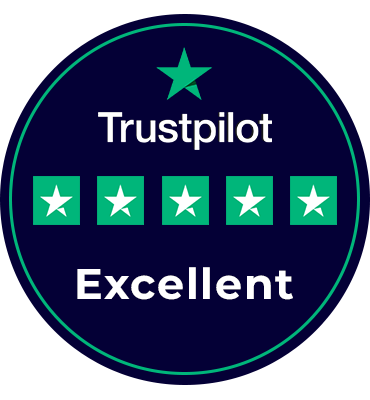Know Color Prediction Game Development Cost
Manish Kumawat
Last Updated on: 06 November 2025
Watch your surroundings! The trend of gaming is growing day by day as people spend countless hours playing games across various platforms. Innovative and engaging games are released daily and those who invest in game development are harvesting a huge benefit.
If you want to see this trend just visit the Google Play Store or Apple Play Store and check the number of downloads of some major games. The market for video games is predicted to have 1,472.0 million users by 2027. This means the trend will continue in the coming years.
If we ask the previous generation, they may say that gaming is just childish and just a hobby. But things changed. Now, gaming has become a major revenue generation for game developers, gamers, and many others associated with the gaming industry. Those who have innovative ideas and feature-rich games can rule this industry. Are you planning to launch a color prediction game? Understanding the color prediction game development cost is crucial for budgeting and execution. Many companies are now turning to multigaming platform development companies to integrate color prediction games with other popular gaming modules.
At the same time, game development companies are developing some interesting games that recreate the games we played during childhood. Ludo, color prediction, and snake ladder are popular games in this trend. The specialty of these games is that more than a gaming experience, these games are easily connected to us, especially with our childhood memories. As a result, entrepreneurs and game developers are increasingly interested in building such games.
However, one of the major considerations when developing a Color Prediction game is understanding the associated costs. Here we will take a comprehensive look at the cost of developing a Color Prediction game. We will explore the various factors that affect the overall price, including game design, platform choice, features, technology, and other development expenses.
What is a Color Prediction Game?
Before understanding the costs of developing a Color Prediction game, it’s important to understand what this type of game entails.
A Color Prediction game typically revolves around the premise of predicting which color will appear next in a particular scenario. This could be anything from predicting the outcome of a color-based wheel spin, guessing the color of a hidden object, or selecting the correct color in a series of choices. Some of these games may involve elements of chance, skill, or a combination of both. These include games like Numbered Ball Draw, Wheel Prediction, Card-Based Color Prediction, Dice Games, Color Memory Challenges, and Nuroulette-style games.
The uniqueness of Color Prediction games is their simplicity. They don’t require players to engage in complex decision-making, making them highly accessible. These games can be played casually, but they often involve a rewards or gambling system that draws in a wide range of players.
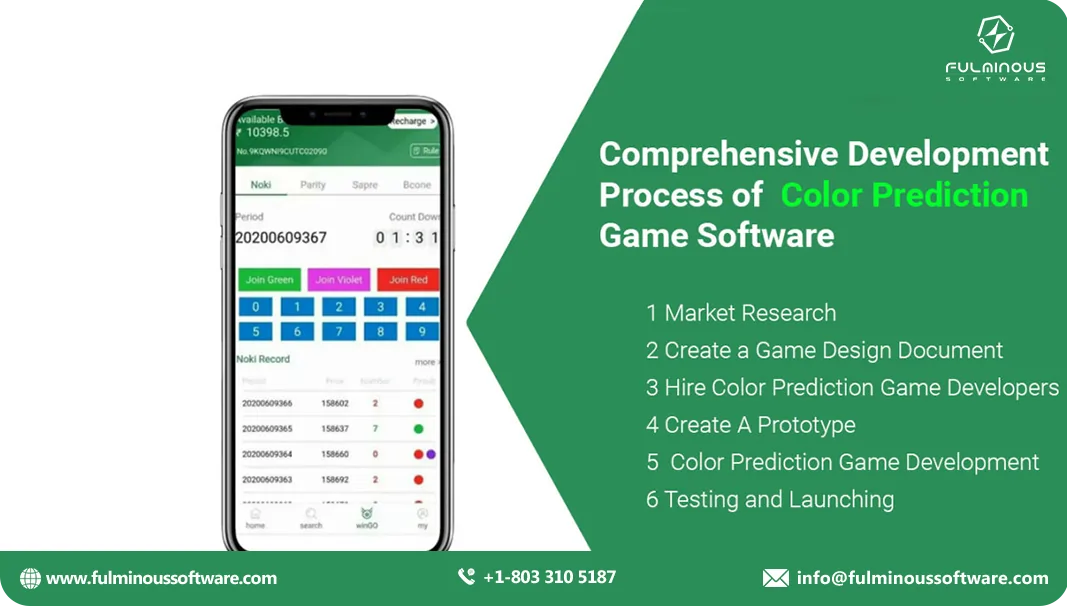
Benefits of Color Prediction Game Development
When you see the cost of color prediction game development, you may ask what are its benefits. That is why, before discussing the cost of color prediction game development, let’s see its benefits.
- High-Profit Potential: Color prediction games have low development costs but offer high revenue opportunities, making them attractive to investors.
- Rapid Growth: These games can quickly gain popularity, leading to fast returns on investment with increasing user engagement.
- Low Operational Costs: With simple features and mechanics, ongoing costs are minimal, boosting overall profitability for investors.
- Scalable Business: Investors can expect growth by expanding the game with new features or launching on multiple platforms.
- User Retention: Color prediction games offer easy-to-learn mechanics, which help keep players engaged for longer periods, increasing revenue.
- Global Market: The simplicity and appeal of color prediction games attract a wide global audience, ensuring a larger market reach.
- Diversified Revenue Streams: Investors can benefit from multiple income sources like in-app purchases, ads, and premium features.
- Low-Risk Investment: With a proven concept, color prediction games carry less financial risk for investors compared to more complex games.
- Faster Development: These games are quicker to develop, allowing investors to see returns sooner than in other gaming projects.
- Branding Opportunities: Investors can use the game’s popularity to create spin-offs or collaborate with brands for cross-promotions.
Factors Influencing the Development Cost of a Color Prediction Game
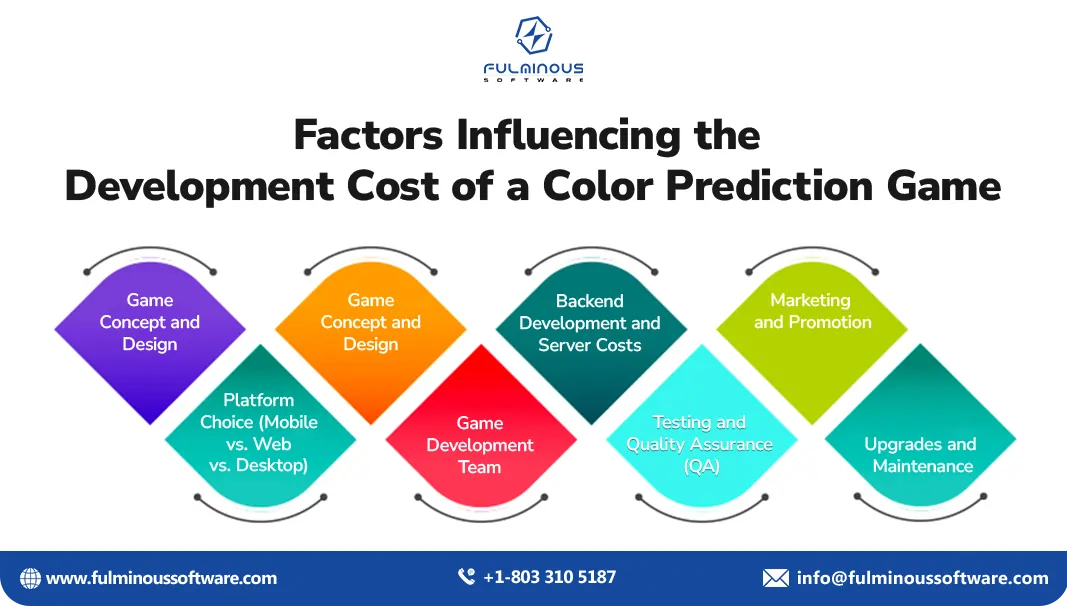
As you know, there are several factors that directly influence the developmental cost of color prediction development games. Here we will see each factor one by one.
1. Game Concept and Design
The first step in the development of any game is conceptualization. Here you have to decide the type of color prediction you want to develop. Along with that, you have to finalize the needed features for your game. For Color Prediction games, this includes mechanics and features. The more complex the color prediction game, the higher the design costs will be. But you can’t negotiate or ignore the important features and UI/UX. If the color prediction game is simple, the cost may be lower.
Cost Range: $1,000 - $5,000
2. Platform Choice (Mobile vs. Web vs. Desktop)
Choosing the platform for your Color Prediction game is a crucial decision that directly impacts the development cost.
-
Mobile Game Development: In a generation where mobiles are part of our daily lives,
mobile game app development is the best choice. But in the same, you have 3 options:
- Make a Color Prediction game app for Android
- Make a Color Prediction game app for iOS
- Make a Color Prediction game application for iOS and Android (cross-platform)
- Web-Based Game: With an estimated number of 5.52 billion internet users worldwide, web-based games can also be a great revenue generation choice for you.
- Desktop Game Development: Developing for desktop (Windows or Mac) or color prediction game software development can be more costly due to the need for specialized software and optimizations.
How much to build a mobile app? Find out the estimated budget for your app idea.
Cost Range: Mobile games - $10,000 to $40,000 (iOS and Android)
Web games - $5,000 to $15,000
Desktop games - $20,000 to $50,000
3. Game Features and Functionality
No doubt, the design, and features of your game are the two major things that influence your game’s success. The features you add to the game will affect how much it costs to make. At the same time, you must add the necessary features.
Otherwise, your game may not succeed as you expected. Today those who download games first compare games. They choose games with better features. Here are some features that are common in Color Prediction games:
- User Interface (UI): This is how the game looks and how easy it is for players to use. It includes things like buttons and game menus.
- Color Prediction Mechanics: This is the main part of the game where players guess the colour outcome. Simple games cost less, but more complicated ones cost more.
- Gamification Elements: Adding things like rewards, scores, and levels makes the game more fun but also costs more.
- Multiplayer or Social Features: Letting players compete with each other or share their scores can make the game more fun, but it also costs extra.
- In-App Purchases (IAP): If you want players to buy things in the game, it will make the game more expensive to develop.
- Graphics and Animations: How the game looks, with pictures and animations, can also make the game cost more depending on how fancy you want it.
Cost Range: $5,000 - $30,000
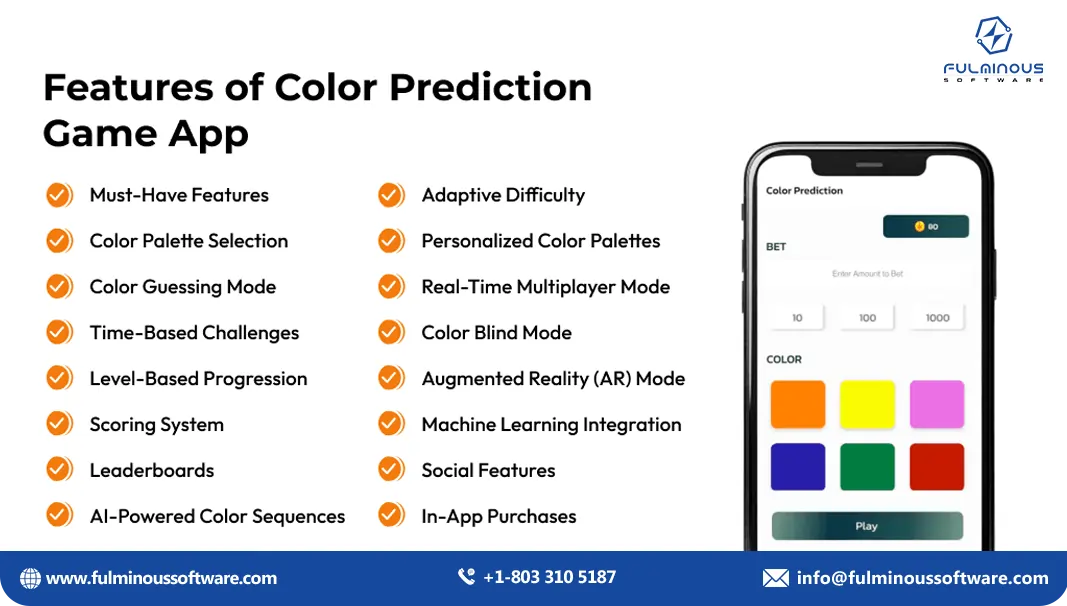
4. Game Development Team
Here comes the one major thing that has a direct impact on the cost of color prediction game development. That is your choice of game development team. Your choice of game development team will also affect the overall development cost. You may choose to work with:
- Freelancers: Hiring freelance color prediction game developers or designers may be a cost-effective option, but you may encounter challenges with communication, quality, and coordination.
- In-House Team: Building an in-house team for color prediction game development can be more expensive, but it provides more control over the project and potentially better quality.
- Game Development Agency: A full-service game development agency will offer a complete package for color prediction game development, from design and development to testing and marketing. This offers a high level of expertise and experience.
Freelancers: $5,000 - $20,000
In-House Team: $20,000 - $100,000 (depending on team size and expertise)
Agency: $30,000 - $200,000
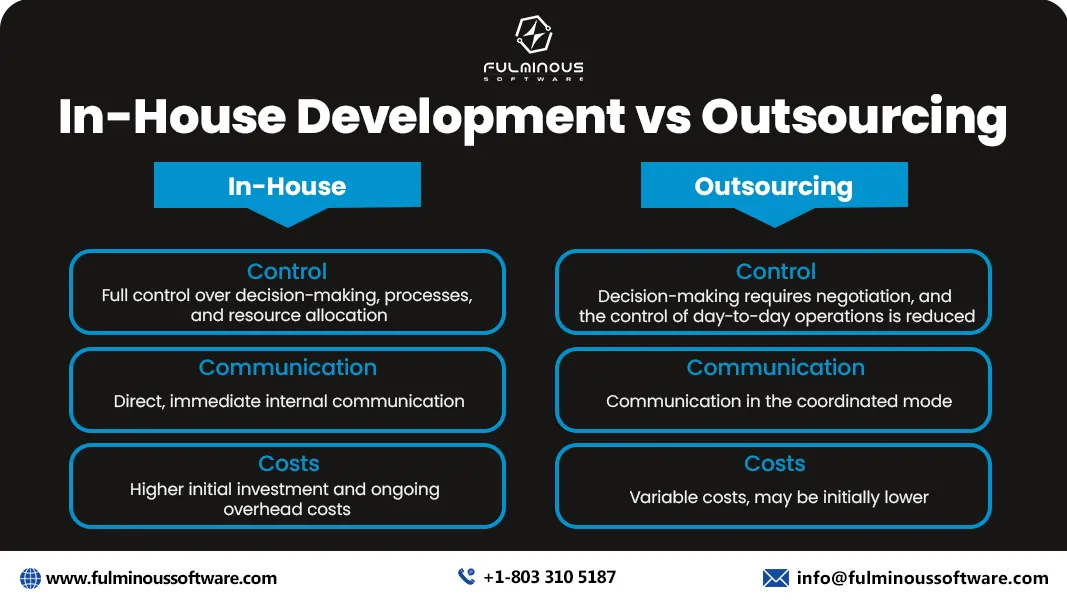
5. Backend Development and Server Costs
If your game requires an online multiplayer mode or has a system for storing player data, you will need a backend infrastructure. This includes setting up servers, databases, and cloud services to store user information, track progress, and manage gameplay. Server costs can vary greatly depending on the scale of your game.
This cost will depend on:
- Number of servers needed
- The volume of players
- The level of customization
Cost Range: $2,000 - $15,000
6. Testing and Quality Assurance (QA)
Before launching your Color Prediction game, it’s essential to conduct thorough testing and quality assurance. Nowadays, users are more concerned about the safety and privacy that your game provides. As there are many games that made for data theft, cyber-attacks, and other misuse, it is your responsibility to create store trust in your users.
Once they have 100% trust, they may suggest to others also. Testing ensures that the game is free of bugs, runs smoothly across all platforms, and provides a seamless user experience. QA costs can increase if the game has complex features or is released across multiple platforms.
Cost Range: $2,000 - $10,000
Thorough testing is essential for ensuring a smooth user experience and avoiding post-launch issues.
7. Marketing and Promotion
Once your game is developed, you will need to set a budget for marketing and promotion. You have to cover both online and offline marketing. But nowadays gaming companies use digital marketing to catch maximum users.
This includes costs for advertising, social media promotion, influencer partnerships, and app store optimization (ASO). Effective marketing can significantly affect the success of your Color Prediction game. Marketing costs will vary depending on your target audience and the strategies you employ.
Cost Range: $3,000 - $20,000
8. Upgrades and Maintenance
After the initial release of your Color Prediction Game, your job is not over. If you ask gamers, they are more concerned about updates, and some of them eagerly wait for updates just like waiting for a famous film release.
When you upgrade your Color Prediction Game, you can catch new users along with holding current users. Even though upgrades are done with a time gap, you need to consider maintenance by taking feedback from users.
The updates may include:
- Bug fixes
- New content releases
- Seasonal events
- Game balance changes
Cost Range: $1,000 - $5,000 per month

Let’s Breakdown the Development Cost of a Color Prediction Game
- Concept and Design: $1,000 - $5,000
- Platform Development:
- Mobile (iOS/Android): $10,000 - $40,000
- Web-Based: $5,000 - $15,000
- Desktop: $20,000 - $50,000
- Game Features: $5,000 - $30,000
- Development Team: $5,000 - $200,000 (based on choice)
- Backend Development and Servers: $2,000 - $15,000
- Marketing and Promotion: $3,000 - $20,000
- Maintenance and Updates: $1,000 - $5,000 per month
Total Estimated Cost:
- Color Prediction game: $20,000- $50,000.
- Advanced games: $25,000- $80,000.
7 Tips to Cut Down the Development Cost of a Color Prediction Game
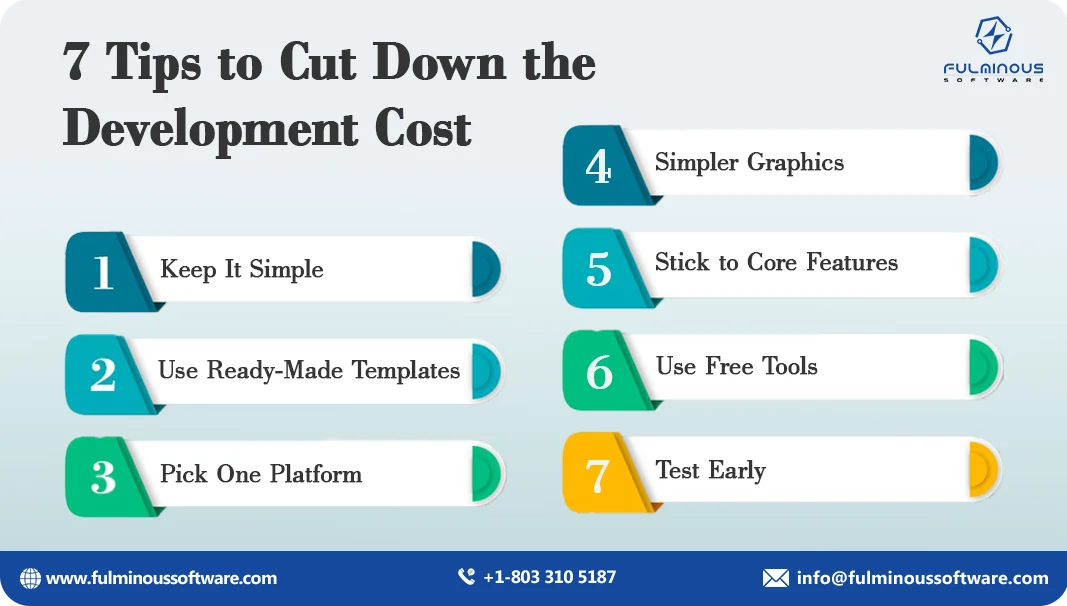
The key specialty of game development like Color Prediction, Ludo, and Snake Ladder is their low cost of development compared to other games. But when you go for color prediction game development, you can save a huge amount of money by considering the following tips.
1. Keep It Simple
Don’t think that you must start big. But small efforts and steps can be expanded later. Make the Color Prediction Game simple and avoid adding too many features. The less complex, the cheaper it is to make.
2. Use Ready-Made Templates
Template game designs can be a great money saver for you. Use pre-made designs or game templates instead of making everything from scratch. Remember you need to make more better later.
3. Pick One Platform
If your budget is less and you want to save developmental costs, begin with development for one platform. Start by making the Color Prediction Game for just one platform, like mobile or web, to keep costs lower.
4. Simpler Graphics
You can begin with simple graphics for color prediction game development. Later you can enhance them as per your wallet allows. Instead of fancy, detailed ones, you can develop color prediction games with simple graphics and save a huge amount.
5. Stick to Core Features
Even though there are several features that can make your game more popular, focus on the main idea of the game and avoid adding too many extra things. If you collaborate with a color prediction game development company, they can guide you in choosing the core features.
6. Use Free Tools
Today there are plenty of free tools and resources that can cut down your overall color prediction game development process. Use free or low-cost tools and software to help with game development. Top-class color prediction game development like Fulminous Software can do this task for you.
7. Test Early
The method of taking precautions is important in every process. Test the game in the initial stage of development often to find problems early and fix them before they get expensive. Hire the best color prediction game developers, so that they can help you conduct strong tests.
Make Money from Your Color Prediction Game
As we have discussed all about the investment in color prediction game development, now we can explore the return and profit from it.
| Monetization Method | Description |
|---|---|
| 1. In-App Purchases (IAPs) |
|
| 2. Ad Revenue |
|
| 3. Subscription Models |
|
| 4. Entry Fees and Tournaments |
|
| 5. Sponsorship and Partnerships |
|
| 6. Affiliate Marketing |
|
| 7. Merchandising |
|
| 8. Referral Programs |
|
Conclusion
In short, if you invest the color prediction game development, your reward is guaranteed. The trend of people wanting to recreate old memories is the key to this guarantee. At the same time, you need to consider the developmental cost of your color prediction game development.
There are several elements that influence the overall cost of development. It includes the type of game, features, design, team, marketing, maintenance, and many more. If you want to cut down the cost of color game development, you can consider the above-mentioned tips to stick to your budget.
Along with that, remember to maintain a high quality to your color prediction game. If you ignore features of your game to reduce the cost, you may fall behind your competitors. Remember one thing: there are plenty of options to monetize your color prediction game. So that you can make maximum ROI from your investment.
If you check the game and online gambling industry you can see there are some leading color prediction games that make millions of dollars in profit. Don't worry even though there are strong competitors for you, if you bring some innovative ideas, you can beat them easily.
If you hire a top-notch color prediction game development service provider, they can create the best game that fits your budget. If you are a developer, entrepreneur, or gaming studio looking to create a Color Prediction game, you can collaborate with Fulminous Software for Comprehensive Color Prediction game development services. Contact now!
FAQs
- 1. What is a Color Prediction Game?
- A Color Prediction game is a game where players guess which color will appear next. It could be from spinning a wheel, choosing a color, or guessing the color of an object.
- 2. What is the overall cost to make a Color Prediction Game?
- The cost can vary. A simple game may cost between $20,000 and $50,000, while a more complex one could cost $25,000 to $80,000.
- 3. Which platforms can I make a Color Prediction Game for?
- You can make the game for:
- Mobile phones (iOS/Android): $10,000 to $40,000
- Web-based game (website): $5,000 to $15,000
- Desktop (PC/Mac): $20,000 to $50,000
- 4. What are the main features to include in the game?
- Important features are:
- User Interface (UI)
- Prediction Mechanics
- Real-time Rewards and Levels
- Multiplayer
- In-App Purchases
- Graphics and Animations
- 5. How long does it take to make a Color Prediction Game?
- A simple game can take around 2 to 6 months to make, but a more complex game could take 6 to 12 months or longer.
- 6. What are the ongoing costs after the game is made?
- You’ll have to pay for:
- Servers: If you need online features. ($2,000 to $15,000)
- Testing: To fix bugs and improve the game. ($2,000 to $10,000)
- Marketing: To promote your game. ($3,000 to $20,000)
- Updates: For bug fixes and new content. ($1,000 to $5,000 per month)
- 7. How can I lower the development cost?
- Here are some tips:
- Keep it simple
- Use templates
- Start with one platform
- Simpler graphics
- Focus on main features
- Use free tools
- Test early
- 8. Is making a Color Prediction Game profitable?
- Yes, Color Prediction games can make good money because they are simple to make and have many ways to earn money, like ads or in-app purchases.
HIRE A TOP SOFTWARE DEVELOPMENT COMPANY

 Verified
Expert in Software & Web App Engineering
Verified
Expert in Software & Web App Engineering
I am Manish Kumawat, co-founder of Fulminous Software, a top leading customized software design and development company with a global presence in the USA, Australia, UK, and Europe. Over the last 10+ years, I am designing and developing web applications, e-commerce online stores, and software solutions custom tailored according to business industries needs. Being an experienced entrepreneur and research professional my main vision is to enlighten business owners, and worldwide audiences to provide in-depth IT sector knowledge with latest IT trends to grow businesses online.
Partner with Top-Notch Web Application Development Company!
Discuss your Custom Application Requirements on info@fulminoussoftware.com or call us on +1-903 488 7170.
15 Days Risk-Free TrialRecommended Articles

